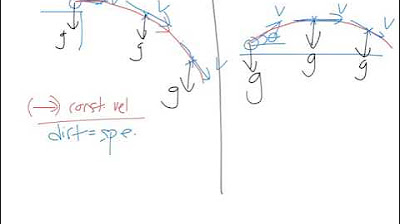How Do Horizontally Launched Projectiles Behave? | Physics in Motion
Summary
TLDRThis video segment introduces the concept of two-dimensional projectile motion, focusing on horizontally launched projectiles. It explains how horizontal and vertical motions are independent, highlighting that while a projectile moves horizontally at a constant velocity, gravity continuously accelerates it downward. Using a practical example with baseballs, the video illustrates how both a ball thrown horizontally and one dropped will hit the ground simultaneously. The segment concludes by solving a projectile motion problem, demonstrating the calculation of time and velocity for the thrown ball, ultimately providing a deeper understanding of projectile dynamics.
Takeaways
- 🎯 The script introduces the concept of motion in two dimensions, specifically focusing on horizontally launched projectiles.
- 📏 In one-dimensional motion, objects travel in a straight line, while in two-dimensional motion, objects can move both horizontally and vertically.
- 🏏 A problem is presented involving two baseballs: one thrown horizontally and one dropped, to determine which hits the ground first.
- 🌌 Horizontal and vertical motions of an object are independent of each other, allowing for separate analysis.
- ⚖️ Once a projectile is in motion, no horizontal forces act on it, meaning it continues at a constant velocity unless affected by another force.
- 🌍 Gravity is the constant force that accelerates objects downward, impacting vertical motion.
- 🔄 The vertical displacement during the projectile's motion is crucial to understanding its trajectory.
- 📊 Key equations are introduced: one for horizontal motion (velocity = distance/time) and three for vertical motion involving acceleration.
- 🔬 The trajectory of projectiles follows predictable laws of physics, with both balls hitting the ground simultaneously despite different horizontal motions.
- 🚀 The example calculations demonstrate how to determine the hang time and horizontal velocity of a projectile, leading to a calculated speed of 33.5 meters per second.
Q & A
What is the main focus of the video segment?
-The segment focuses on understanding two-dimensional projectile motion, specifically horizontal projectiles.
How do horizontal and vertical motions differ in projectile motion?
-Horizontal and vertical motions are independent of each other. Horizontal motion occurs at a constant velocity, while vertical motion is influenced by gravity, which accelerates the object downward.
What force affects the vertical motion of a projectile?
-Gravity is the force that constantly accelerates the projectile downward at approximately 9.8 meters per second squared.
What is the significance of the equation 'velocity equals distance divided by time'?
-This equation is used for horizontal motion where there is no acceleration, allowing us to calculate the horizontal velocity of a projectile.
Which equations are used for vertical motion in projectile motion problems?
-The three key equations for vertical motion include: Final velocity = initial velocity + (acceleration × time), Final velocity squared = initial velocity squared + (2 × acceleration × displacement), and Displacement = (initial velocity × time) + (1/2 × acceleration × time squared).
What was the example problem presented in the video?
-The example involved two baseballs: one thrown horizontally by a pitcher and the other dropped by a catcher from the same height. The video aimed to determine which ball would hit the ground first.
What did the experiment with the two baseballs demonstrate?
-The experiment showed that both balls hit the ground simultaneously, illustrating that horizontal and vertical motions are independent and obey the laws of physics.
How is hang time defined in this context?
-Hang time refers to the duration that a projectile, like a baseball, remains in the air before hitting the ground.
What calculations were made to determine the speed of the projectile?
-The hang time was calculated using the vertical displacement and gravitational acceleration, followed by using the hang time to calculate the horizontal velocity using the distance traveled.
What is the final calculated velocity of the baseball thrown by the pitcher?
-The final calculated velocity of the baseball thrown horizontally was 33.5 meters per second, which is approximately equivalent to 75 miles per hour.
Outlines

This section is available to paid users only. Please upgrade to access this part.
Upgrade NowMindmap

This section is available to paid users only. Please upgrade to access this part.
Upgrade NowKeywords

This section is available to paid users only. Please upgrade to access this part.
Upgrade NowHighlights

This section is available to paid users only. Please upgrade to access this part.
Upgrade NowTranscripts

This section is available to paid users only. Please upgrade to access this part.
Upgrade NowBrowse More Related Video
5.0 / 5 (0 votes)





